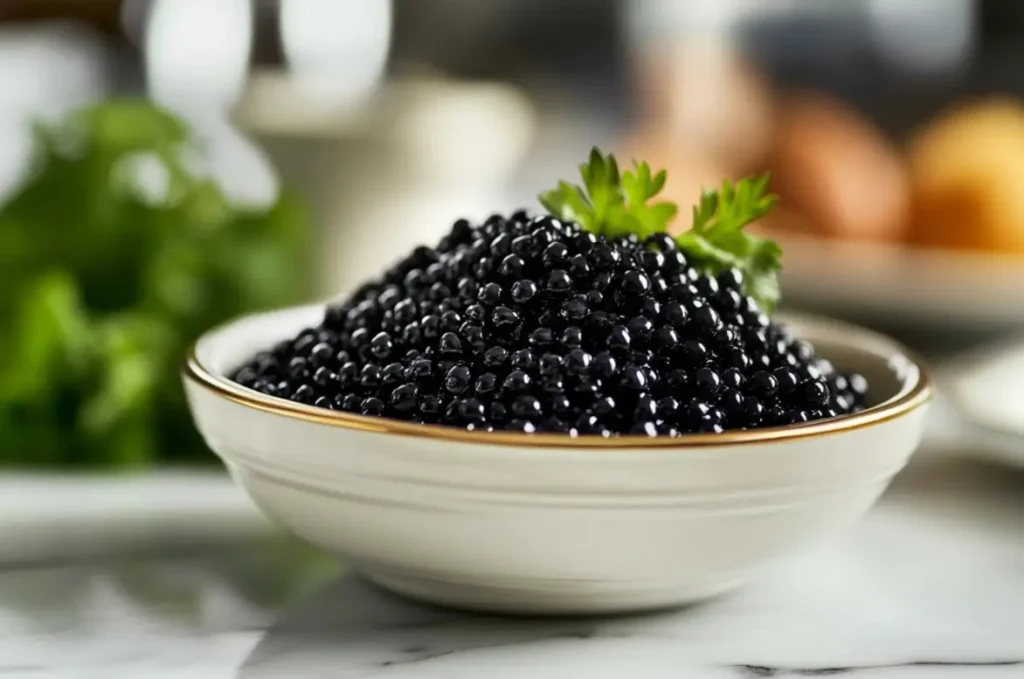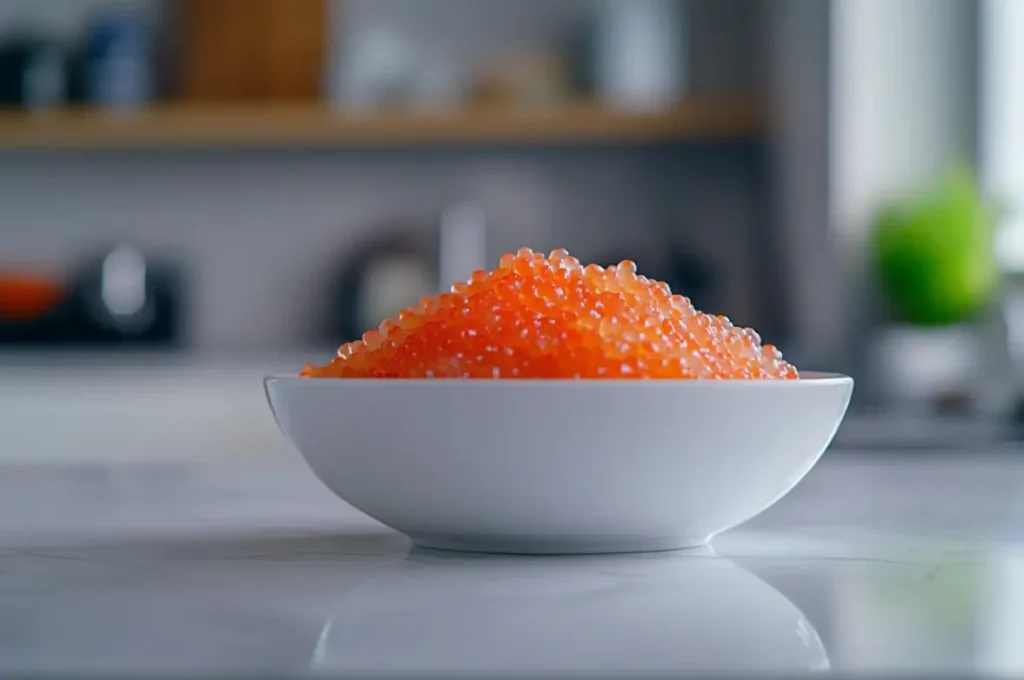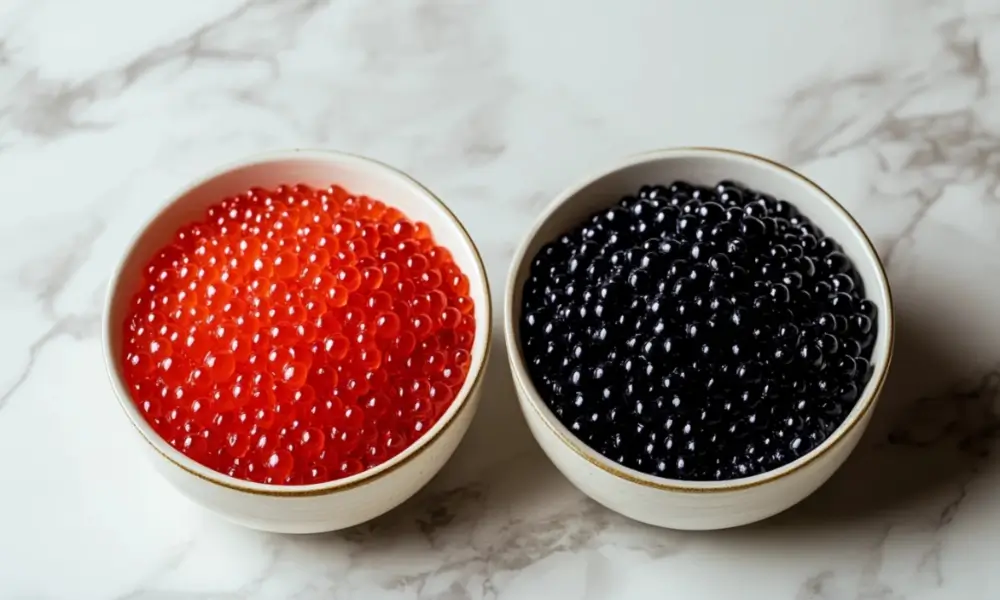Let’s be honest: when we hear about caviar or tobiko, our minds often jump to fancy sushi platters or lavish appetizers served at high-end parties. But are these two types of fish roe really the same thing? 🤔 Spoiler alert: they’re not! Sure, they might look similar at first glance, but there’s a whole world of difference between them. Buckle up, because we’re diving into the depths of what makes caviar and tobiko unique and why they’re such prized culinary delights.
Understanding the differences between these two can help you appreciate their distinct roles in the culinary world. Whether you’re a sushi lover or a food enthusiast trying to elevate your gourmet game, this guide will give you all the juicy (or should we say “fishy”) details. From their origins to their flavors, textures, and even their price tags, we’ll uncover everything you need to know. Let’s get started!
What Is Caviar?

Let’s start with caviar, the crown jewel of fish roe. Often seen as the epitome of luxury, caviar is derived from sturgeon fish. But here’s the catch (pun intended): not all fish roe qualifies as caviar. Authentic caviar only comes from sturgeon species like beluga, osetra, and sevruga. Fancy, huh?
The world of caviar is steeped in tradition and exclusivity. For centuries, this delicacy has been associated with royalty and aristocracy, making it a symbol of wealth and sophistication. But beyond its glamorous reputation, caviar is also an incredibly versatile ingredient that can elevate even the simplest dishes. Ever tried it on buttered toast? It’s a game-changer!
Origins and Types of Caviar
Caviar has a rich history that dates back to ancient Persia, where it was revered as a health elixir. Today, it’s most commonly associated with regions like Russia and Iran. The Caspian Sea and the Black Sea have long been the primary sources of high-quality caviar, thanks to their abundance of sturgeon species.
Did you know that the type of sturgeon determines the flavor and price of caviar? For instance:
- Beluga Caviar: Creamy and buttery, this is the Rolls Royce of caviar. It’s incredibly rare and expensive, often reserved for the most special occasions.
- Osetra Caviar: Nutty with a golden hue, this variety offers a complex flavor profile that’s cherished by connoisseurs.
- Sevruga Caviar: A more affordable option with an intense, briny taste. It’s perfect for those looking to indulge without breaking the bank.
Each type has its own unique charm, making it a must-try for any foodie looking to explore the finer things in life.
How Caviar Is Harvested
Harvesting caviar isn’t as simple as scooping up fish eggs. The process involves carefully extracting the roe from sturgeon without damaging the eggs. In modern aquaculture, sustainable methods like striping are used to ensure the fish survive the process. Pretty cool, right?
Traditional methods, on the other hand, were less fish-friendly and often led to the death of the sturgeon. Thankfully, advancements in technology and a growing awareness of sustainability have paved the way for more ethical practices. This shift not only helps protect sturgeon populations but also ensures that we can enjoy caviar for generations to come.
Flavor Profile and Culinary Uses of Caviar
Ever tasted caviar? It’s like a burst of ocean goodness in your mouth—salty, buttery, and smooth. The texture is equally divine, with the eggs almost melting on your tongue. Caviar is often served on blinis, crackers, or toast points, but it’s also a fantastic addition to pasta, omelets, and even baked potatoes. Want to elevate your scrambled eggs? Add a dollop of caviar, and voilà—you’re living the high life!
“Caviar is like the little black dress of food—it never goes out of style and makes everything classier.”
Despite its luxury status, caviar isn’t just for the elite. Many gourmet stores now offer more affordable options, making it accessible to a wider audience. So, if you’ve never tried it, what are you waiting for? Go ahead and treat yourself!
What Is Tobiko?

Now, let’s talk about tobiko, the pop of color and crunch you’ve probably seen on sushi rolls. Tobiko is the roe of flying fish and is a staple in Japanese cuisine. While it may not have the high-brow reputation of caviar, it’s equally delightful in its own way.
If caviar is the elegant ballerina of the fish roe world, tobiko is the fun, vibrant breakdancer. It’s playful, colorful, and brings a unique texture to dishes. Whether you’re a sushi aficionado or a casual diner, you’ve likely encountered tobiko in some form. Its bright orange hue and crunchy texture make it a standout ingredient in any dish.
Origins and Cultural Significance of Tobiko
Hailing from the waters of Japan, tobiko is deeply rooted in sushi culture. It’s often used as a garnish to add both texture and visual appeal to dishes. Fun fact: the vibrant orange hue of tobiko isn’t always natural—it’s often enhanced with natural ingredients like yuzu or squid ink for added flair.
In Japanese cuisine, tobiko represents joy and celebration. Its vibrant colors are believed to bring happiness, which is why it’s often featured in festive dishes. Plus, it’s incredibly versatile, making it a favorite among chefs worldwide.
How Tobiko Is Harvested and Processed
The process of obtaining tobiko is much simpler compared to caviar. The roe is gently collected from flying fish, cleaned, and cured. Its tiny, crunchy texture makes it a hit in sushi rolls and sashimi plates.
Unlike caviar, tobiko is often flavored during the curing process. This is where it gets its unique colors and tastes. For example:
- Green Tobiko: Flavored with wasabi for a spicy kick.
- Black Tobiko: Enhanced with squid ink for a dramatic look.
- Red Tobiko: Naturally bright with a touch of spice.
These variations add an extra layer of excitement to dishes, making tobiko a favorite among adventurous eaters.
Flavor Profile and Common Uses of Tobiko
Unlike the creamy texture of caviar, tobiko has a delightful crunch and a mildly sweet flavor with a hint of saltiness. It’s often sprinkled over sushi or used as a topping for poke bowls and seafood salads. Plus, it comes in fun colors like green (thanks to wasabi) and black (thanks to squid ink). How’s that for variety?
Beyond sushi, tobiko is also used in fusion dishes like pasta, dips, and even burgers. Its versatility knows no bounds, making it a must-have ingredient for anyone looking to experiment in the kitchen.
“Tobiko isn’t just an ingredient; it’s a conversation starter on your plate.”
Comparing Caviar and Tobiko: Key Differences
At this point, you’re probably wondering, “So, how exactly are caviar and tobiko different?” On the surface, they might appear similar—after all, they’re both types of fish roe. But dig a little deeper, and you’ll find they’re as different as chalk and cheese. Let’s break it down:
Source and Species of Fish
The most significant difference between caviar and tobiko lies in their origins. Caviar exclusively comes from sturgeon, a species that’s been around for over 200 million years. Talk about a prehistoric delicacy! On the other hand, tobiko is harvested from flying fish, which are known for their ability to glide over water. Fun fact: flying fish are the acrobats of the ocean, making their roe just as lively and exciting!
Think of it this way: if caviar were a refined violin concerto, tobiko would be a vibrant jazz solo. Both are music to your taste buds but in entirely different ways.
Texture, Size, and Appearance
Texture is where these two really set themselves apart. Caviar eggs are larger, softer, and almost melt in your mouth like tiny pearls of oceanic luxury. Tobiko, on the other hand, is smaller, crunchier, and has a distinct “pop” when you bite into it. It’s like comparing silk to sequins—each has its charm, depending on the vibe you’re going for.
Appearance-wise, caviar tends to have a subdued elegance with its shades of black, grey, or golden brown. Tobiko? It’s the life of the party with its vibrant orange, green, black, or even red hues. If caviar is the little black dress of the culinary world, tobiko is the neon jumpsuit—bold, fun, and impossible to ignore! 🌈
Price and Availability
Let’s not sugarcoat it: caviar is expensive. Depending on the variety, a small tin can set you back hundreds (or even thousands) of dollars. Why? The rarity of sturgeon, the labor-intensive harvesting process, and the years it takes for sturgeon to mature all add to the cost. In contrast, tobiko is much more budget-friendly, with its production being less complex and flying fish being more abundant.
If you’re planning a fancy dinner party, splurging on caviar might make a statement. But if you’re looking for a wallet-friendly way to jazz up your sushi night, tobiko is the way to go. After all, who says luxury has to break the bank?
Nutritional Value of Caviar vs. Tobiko
Here’s a quick look at how these two stack up nutritionally:
| Nutrient | Caviar (1 tbsp) | Tobiko (1 tbsp) |
|---|---|---|
| Calories | 40 | 20 |
| Protein | 4g | 3g |
| Fat | 3g | 1g |
| Sodium | 240mg | 300mg |
Caviar is richer in protein and healthy fats, making it a more nutrient-dense option. Tobiko, however, is lower in calories and offers a satisfying crunch, which might appeal to those watching their waistlines.
“Caviar and tobiko may share the spotlight, but they each bring something unique to the table.”
Common Misconceptions About Caviar and Tobiko
Let’s clear up some common myths, shall we? There’s a lot of confusion surrounding these two, and it’s time to set the record straight.
Are They Interchangeable in Recipes?
Short answer: not really. While both are types of fish roe, their textures and flavors are worlds apart. Caviar’s buttery, delicate flavor makes it ideal for elegant dishes, whereas tobiko’s crunch and vibrant taste are better suited for bold, playful creations. Imagine swapping caviar for tobiko in a fine dining setting—it’s like wearing sneakers to a black-tie event. Sure, you could do it, but it might raise a few eyebrows.
Do Tobiko and Caviar Taste the Same?
Nope! Caviar has a rich, briny flavor with a creamy texture, while tobiko is lighter, sweeter, and has a subtle smokiness. It’s like comparing chocolate to caramel—they’re both delicious but satisfy completely different cravings.
Common Problems and Questions About Caviar and Tobiko
When it comes to handling and enjoying fish roe, a few common challenges might pop up. Let’s tackle them so you can enjoy your caviar or tobiko hassle-free.
Identifying Authentic Caviar and Tobiko
With so many imitations on the market, it’s easy to get duped. Authentic caviar comes from sturgeon, while tobiko is from flying fish. Always check the label, and buy from reputable suppliers. If the price seems too good to be true, it probably is!
Storing and Preserving Fish Roe
Fish roe is delicate and needs proper storage to maintain its quality. Caviar should be kept refrigerated and consumed within a few days of opening. Tobiko, on the other hand, has a longer shelf life and can even be frozen for extended storage. A little tip? Always store them in an airtight container to prevent any unwanted odors from seeping in.
What to Do If You Have a Fish Allergy?
If you’re allergic to fish, consuming caviar or tobiko is a no-go. But don’t worry—you can still enjoy the aesthetic appeal of fish roe by using plant-based alternatives like vegan caviar made from seaweed. These options mimic the texture and look of fish roe without triggering allergies. 🌱
Tips for Choosing Between Caviar and Tobiko
Still on the fence about which one to try? Here are some tips to help you decide:
Considering Budget and Culinary Use
If you’re looking to impress at a dinner party, splurging on caviar might be worth it. But for everyday meals or casual gatherings, tobiko is a more practical choice. Both have their place—it all depends on the occasion and your budget.
Pairing Suggestions for Each
Caviar pairs beautifully with sparkling water infused with lemon or a delicate herbal tea like chamomile. Tobiko, on the other hand, shines in sushi rolls, poke bowls, or even as a garnish for deviled eggs. Experiment and find your favorite combinations!
“Choosing between caviar and tobiko is like picking your favorite child—they’re both special in their own way.”
FAQs: Answers to Popular Questions About Caviar and Tobiko
Still curious? Here are some frequently asked questions about caviar and tobiko, along with simple, straightforward answers to clear up any lingering confusion.
Is Tobiko a Type of Caviar?
No, tobiko is not a type of caviar. While both are fish roe, they come from entirely different species—caviar from sturgeon and tobiko from flying fish. Think of them as distant cousins rather than siblings.
Can You Substitute Tobiko for Caviar in Recipes?
Technically, yes, but it depends on the recipe. If you’re making sushi or a seafood salad, tobiko works well. However, for dishes that rely on the creamy, buttery texture of caviar—like a classic caviar toast—tobiko wouldn’t deliver the same luxurious experience.
What’s the Shelf Life of Each?
Caviar and tobiko have different shelf lives. Caviar is highly perishable and should be consumed within a few days of opening. Tobiko, on the other hand, is more resilient and can be stored in the freezer for up to three months. Pro tip: always check the packaging for specific storage guidelines.
Why Is Caviar So Expensive Compared to Tobiko?
The cost of caviar comes down to rarity and production complexity. Sturgeon take years to mature, and their roe is harvested through meticulous, labor-intensive processes. Tobiko, harvested from the more abundant flying fish, is easier and quicker to produce, making it more affordable.
Can Vegetarians or Vegans Eat Caviar or Tobiko?
Unfortunately, no—both caviar and tobiko come from fish. However, plant-based alternatives like vegan caviar (made from seaweed or algae) are excellent substitutes for those following a vegetarian or vegan lifestyle. 🌱
Do Caviar and Tobiko Taste Fishy?
Not really! Caviar has a rich, oceanic flavor that’s more buttery than fishy, while tobiko offers a slightly sweet, briny taste with a crunchy texture. If you’re worried about a strong fishy flavor, don’t be—both are far more refined than you might expect.
Dive Deeper into Tobiko and Seafood Delights
Check out our guide on tobiko to learn more about this vibrant ingredient. For more seafood inspiration, don’t miss our lox bagel guide for a perfect pairing idea!
Final Thoughts: Appreciating the Diversity of Fish Roe
So, there you have it! While caviar and tobiko may share some similarities as fish roe, they are worlds apart in terms of origin, flavor, texture, and price. Whether you’re indulging in the creamy luxury of caviar or enjoying the playful crunch of tobiko, each has its own unique charm and place in the culinary world.
Think of caviar as the elegant evening gown and tobiko as the vibrant cocktail dress—both are stunning, but they cater to different moods and occasions. Whether you’re planning a fancy dinner party or just spicing up your sushi night, knowing the difference can help you choose the right one for the moment.
Next time you’re at a restaurant or gourmet market, why not give both a try? You might just discover a new favorite delicacy. And remember, food isn’t just about sustenance—it’s about exploration, adventure, and enjoying the journey.
“Food is not just fuel; it’s information. It talks to your DNA and tells it what to do.” – Dr. Mark Hyman


